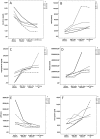Long-term outcomes of the Atypical Hemolytic Uremic Syndrome after kidney transplantation treated with eculizumab as first choice
- PMID: 29136640
- PMCID: PMC5685617
- DOI: 10.1371/journal.pone.0188155
Long-term outcomes of the Atypical Hemolytic Uremic Syndrome after kidney transplantation treated with eculizumab as first choice
Abstract
Introduction: The treatment of choice for Atypical Hemolytic Uremic Syndrome (aHUS) is the monoclonal antibody eculizumab. The objective of this study was to assess the efficacy and safety of eculizumab in a cohort of kidney transplant patients suffering from aHUS.
Methods: Description of the prospective cohort of all the patients primarily treated with eculizumab after transplantation and divided into the therapeutic (onset of aHUS after transplantation) and prophylactic use (patients with previous diagnosis of aHUS undergoing kidney transplantation).
Results: Seven cases were outlined: five of therapeutic use and two, prophylactic. From the five cases of therapeutic use, there was improvement of the thrombotic microangiopathy in the 48 hours following the start of the drug and no patient experienced relapse during an average follow-up of 21 months in the continuous use of eculizumab (minimum of 6 and maximum of 42 months). One patient died at 6 months, due to Aspergillus infection. From the two cases of prophylactic use, one patient experienced relapsed thrombotic microangiopathy after 4 months and another patient remained asymptomatic after 16 months of follow-up, both on chronic treatment.
Discussion: The therapeutic use of eculizumab showed to be effective, with improvement of the microangiopathy parameters and persisting up to the end of the follow-up, without relapses. The additional risk of immunosuppression, leading to opportunistic infections, was well tolerated. The prophylactic use showed to be effective and safe; however, the doses and intervals should be individualized in order to avoid relapsed microangiopathy, especially in patients with factor H mutation.
Conflict of interest statement
Figures

Similar articles
-
Efficacy and safety of eculizumab in adult patients with atypical hemolytic uremic syndrome: A single center experience from Turkey.Transfus Apher Sci. 2016 Dec;55(3):357-362. doi: 10.1016/j.transci.2016.09.017. Epub 2016 Sep 30. Transfus Apher Sci. 2016. PMID: 27742267
-
Living Donor Kidney Transplantation in Atypical Hemolytic Uremic Syndrome: A Case Series.Am J Kidney Dis. 2017 Dec;70(6):770-777. doi: 10.1053/j.ajkd.2017.06.024. Epub 2017 Aug 16. Am J Kidney Dis. 2017. PMID: 28821363
-
Ten-year outcome of Eculizumab in kidney transplant recipients with atypical hemolytic uremic syndrome- a single center experience.BMC Nephrol. 2020 May 20;21(1):189. doi: 10.1186/s12882-020-01847-0. BMC Nephrol. 2020. PMID: 32434487 Free PMC article.
-
Atypical Hemolytic Uremic Syndrome After Kidney Transplantation: Lessons Learned From the Good, the Bad, and the Ugly. A Case Series With Literature Review.Transplant Proc. 2020 Jan-Feb;52(1):146-152. doi: 10.1016/j.transproceed.2019.10.015. Epub 2020 Jan 7. Transplant Proc. 2020. PMID: 31924403 Review.
-
Atypical Hemolytic Uremic Syndrome: New Challenges in the Complement Blockage Era.Nephron. 2020;144(11):537-549. doi: 10.1159/000508920. Epub 2020 Sep 18. Nephron. 2020. PMID: 32950988 Review.
Cited by
-
Kidney Transplantation in Patients With aHUS: A Comparison of Eculizumab Prophylaxis Versus Rescue Therapy.Transplantation. 2025 Mar 1;109(3):511-518. doi: 10.1097/TP.0000000000005135. Epub 2024 Jul 25. Transplantation. 2025. PMID: 39049128 Free PMC article.
-
Therapeutic Lessons to be Learned From the Role of Complement Regulators as Double-Edged Sword in Health and Disease.Front Immunol. 2020 Dec 10;11:578069. doi: 10.3389/fimmu.2020.578069. eCollection 2020. Front Immunol. 2020. PMID: 33362763 Free PMC article. Review.
-
A Rare Case of Atypical Haemolytic Syndrome Following Right Retrograde Intrarenal Surgery (RIRS).Cureus. 2025 Jun 23;17(6):e86585. doi: 10.7759/cureus.86585. eCollection 2025 Jun. Cureus. 2025. PMID: 40704245 Free PMC article.
-
Eculizumab in low-middle income countries: how much does a life cost?J Nephrol. 2022 May;35(4):1255-1257. doi: 10.1007/s40620-022-01282-4. Epub 2022 Apr 2. J Nephrol. 2022. PMID: 35366215
-
Thrombotic microangiopathy after kidney transplantation: Analysis of the Brazilian Atypical Hemolytic Uremic Syndrome cohort.PLoS One. 2021 Nov 8;16(11):e0258319. doi: 10.1371/journal.pone.0258319. eCollection 2021. PLoS One. 2021. PMID: 34748552 Free PMC article.
References
-
- Zuber J, Fakhouri F, Roumenina LT, Loirat C, Frémeaux-Bacchi V. Use of eculizumab for atypical haemolytic uraemic syndrome and C3 glomerulopathies. Nat Rev Nephrol. 2012. November;8 (11):643–57. doi: 10.1038/nrneph.2012.214 . - DOI - PubMed
-
- Nester CM, Barbour T, de Cordoba SR, Dragon-Durey MA, Fremeaux-Bacchi V, Goodship TH, et al. Atypical aHUS: State of the art. Mol Immunol. Mol Immunol. 2015. September;67(1):31–42. doi: 10.1016/j.molimm.2015.03.246 . - DOI - PubMed
-
- Nürnberger J, Philipp T, Witzke O, Opazo Saez A, Vester U, Baba HA, et al. Eculizumab for atypical hemolytic-uremic syndrome. N Engl J Med. 2009. January 29;360(5):542–4. doi: 10.1056/NEJMc0808527 . - DOI - PubMed
-
- Noris M, Remuzzi G. Managing and preventing atypical hemolytic uremic syndrome recurrence after kidney transplantation. Curr Opin Nephrol Hypertens. 2013. November;22(6):704–12. doi: 10.1097/MNH.0b013e328365b3fe . - DOI - PubMed
-
- Noris M, Caprioli J, Bresin E, Mossali C, Pianetti G, Gamba S, et al. Relative role of genetic complement abnormalities in sporadic and familial aHUS and their impact on clinical phenotype. Clin J Am Soc Nephrol. 2010. October;5(10):1844–59. doi: 10.2215/CJN.02210310 . - DOI - PMC - PubMed
MeSH terms
Substances
LinkOut - more resources
Full Text Sources
Other Literature Sources

